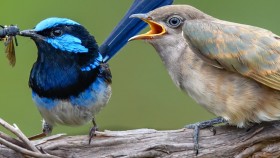Birds cry wolf to scare predators
One of Australia's smallest birds has found a cunning way to protect its nest from predators by crying wolf, or rather hawk, and mimicking the warning calls of other birds.
Researchers from ANU Research School of Biology found that the tiny brown thornbill mimics the hawk warning call of a variety of birds to scare off predators threatening its nest, such as the larger pied currawong.
"It's not superbly accurate mimicry, but it's enough to fool the predator," said Dr Branislav Igic, who carried out the study during his PhD at ANU Research School of Biology.
"A physical attack on a currawong would be no good. They are 40 times the size of a thornbill and will eat adults as well as nestlings.
"I am amazed that such a tiny bird can mimic so many species, some much bigger than itself. It's very cunning," said Dr Igic, who has now taken up a position at the University of Akron, in Ohio, United States.
Although vocal mimicry is widespread amongst birds, its function is rarely understood. This study is the first to show that birds use vocal mimicry to scare predators.
The researchers stumbled across the thornbill's deceit during an experiment on bird reaction to a stuffed owl, said Professor Robert Magrath, the leader of the research group at the Research School of Biology.
"I was puzzled because I could hear the alarm calls of robins, honeyeaters and rosellas, but I couldn't see any," he said.
"I soon realised that the brown thornbill was mimicking the other species, and Branislav later discovered that they sometimes lie about the type of predator present when defending their nests," he said.
The researchers also used fake thornbill nests populated with chicken pieces to study the reaction of currawongs, which will typically feed a single brood about two kilograms of baby birds in a season.
When the researchers played recordings of the thornbill's trick calls, the currawongs were distracted for around sixteen seconds, which would be enough for nestlings to flee or seek cover.
The thornbill's own hawk warning call distracted the currawongs for only half as long.
The deception succeeds because currawongs eavesdrop on other species, Professor Magrath said.
"Many species of both birds and mammals eavesdrop on the alarm calls of other species. Natural communities form an information web about danger.
"Currawongs would normally benefit, because they are also vulnerable to hawks, but thornbills turn this against them," he said.
The study is published in the Proceedings of the Royal Society B.
Related links
Journal article
Media
Interviews and podcasts
- Science update (American Association for the Advancement of Science) Podcast interview of Bob Hirshon (host ) with Brani Igic (researcher), Alarm call mimics | Download audio
- ABC Canberra Radio interview (Saturday Breakfast, Professor Rob Magrath with Greg Bayliss, June 6, 6-8am, 8:30-11:00am) - webpage | Download audio
Online articles
- Thornbill scares off predator by mimicking hawk warning, Australian Geographic, 5 June 2015
- Little Aussie bird cries wolf to fool a predator, Nature World News, 3 June 2015
- Birds raise false alarm to scare off predators, Science Shot, 2 June 2015
- Little Aussie bird cries wolf to fool a predator, ABC Science Online, 3 June 2015
- Brown Thornbill Mimics Alarm Calls of Other Birds to Scare off Predators, Sci-News.com, 3 June 2015
- The bird who cried HAWK: Tiny thornbill mimics warning call of other species to scare predators away from its nest, DailyMail Australia, 3 June 2015
- Birds 'cry hawk' to give offspring chance to escape predators, Phys Org, 3 June 2015










